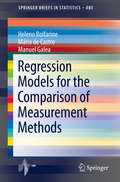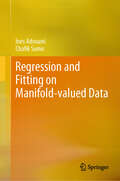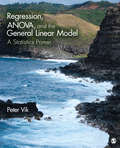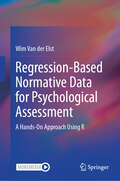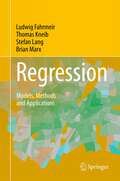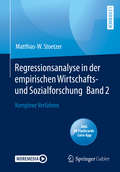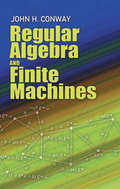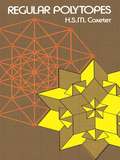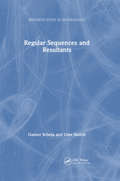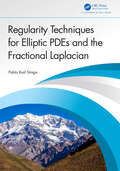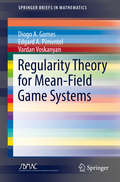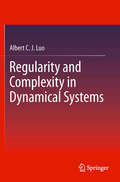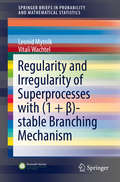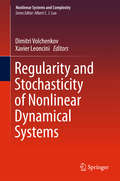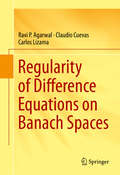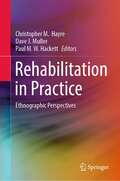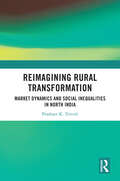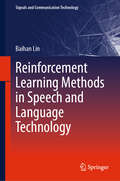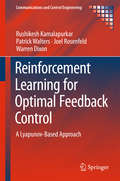- Table View
- List View
Regression Models for Categorical, Count, and Related Variables: An Applied Approach
by Dr John P. HoffmannSocial science and behavioral science students and researchers are often confronted with data that are categorical, count a phenomenon, or have been collected over time. Sociologists examining the likelihood of interracial marriage, political scientists studying voting behavior, criminologists counting the number of offenses people commit, health scientists studying the number of suicides across neighborhoods, and psychologists modeling mental health treatment success are all interested in outcomes that are not continuous. Instead, they must measure and analyze these events and phenomena in a discrete manner. This book provides an introduction and overview of several statistical models designed for these types of outcomes--all presented with the assumption that the reader has only a good working knowledge of elementary algebra and has taken introductory statistics and linear regression analysis. Numerous examples from the social sciences demonstrate the practical applications of these models. The chapters address logistic and probit models, including those designed for ordinal and nominal variables, regular and zero-inflated Poisson and negative binomial models, event history models, models for longitudinal data, multilevel models, and data reduction techniques such as principal components and factor analysis. Each chapter discusses how to utilize the models and test their assumptions with the statistical software Stata, and also includes exercise sets so readers can practice using these techniques. Appendices show how to estimate the models in SAS, SPSS, and R; provide a review of regression assumptions using simulations; and discuss missing data. A companion website includes downloadable versions of all the data sets used in the book.
Regression Models for the Comparison of Measurement Methods (SpringerBriefs in Statistics)
by Heleno Bolfarine Mário de Castro Manuel GaleaThis book provides an updated account of the regression techniques employed in comparing analytical methods and to test the biases of one method relative to others – a problem commonly found in fields like analytical chemistry, biology, engineering, and medicine. Methods comparison involves a non-standard regression problem; when a method is to be tested in a laboratory, it may be used on samples of suitable reference material, but frequently it is used with other methods on a range of suitable materials whose concentration levels are not known precisely. By presenting a sound statistical background not found in other books for the type of problem addressed, this book complements and extends topics discussed in the current literature. It highlights the applications of the presented techniques with the support of computer routines implemented using the R language, with examples worked out step-by-step. This book is a valuable resource for applied statisticians, practitioners, laboratory scientists, geostatisticians, process engineers, geologists and graduate students.
Regression and Fitting on Manifold-valued Data
by Ines Adouani Chafik SamirThis book introduces in a constructive manner a general framework for regression and fitting methods for many applications and tasks involving data on manifolds. The methodology has important and varied applications in machine learning, medicine, robotics, biology, computer vision, human biometrics, nanomanufacturing, signal processing, and image analysis, etc. The first chapter gives motivation examples, a wide range of applications, raised challenges, raised challenges, and some concerns. The second chapter gives a comprehensive exploration and step-by-step illustrations for Euclidean cases. Another dedicated chapter covers the geometric tools needed for each manifold and provides expressions and key notions for any application for manifold-valued data. All loss functions and optimization methods are given as algorithms and can be easily implemented. In particular, many popular manifolds are considered with derived and specific formulations. The same philosophy is used in all chapters and all novelties are illustrated with intuitive examples. Additionally, each chapter includes simulations and experiments on real-world problems for understanding and potential extensions for a wide range of applications.
Regression, ANOVA, and the General Linear Model: A Statistics Primer
by Peter Wright VikPeter Vik′s Regression, ANOVA, and the General Linear Model: A Statistics Primer demonstrates basic statistical concepts from two different perspectives, giving the reader a conceptual understanding of how to interpret statistics and their use. The two perspectives are (1) a traditional focus on the t-test, correlation, and ANOVA, and (2) a model-comparison approach using General Linear Models (GLM). This book juxtaposes the two approaches by presenting a traditional approach in one chapter, followed by the same analysis demonstrated using GLM. By so doing, students will acquire a theoretical and conceptual appreciation for data analysis as well as an applied practical understanding as to how these two approaches are alike.
Regression-Based Normative Data for Psychological Assessment: A Hands-On Approach Using R
by Wim Van der ElstOver the last 20 years, so-called regression-based normative methods have become increasingly popular. In this approach, regression models for the mean and the residual variance structure are used to derive the normative data. The regression-based normative approach has some important advantages over the traditional normative approach, e.g., it allows for deriving more fine-grained norms and typically requires a substantially smaller sample size to derive accurate norms. This book focuses on regression-based methods to derive normative data. The target audience are psychologists and other researchers in the behavioral sciences who are interested in deriving normative data for psychological tests (e.g., cognitive tests, questionnaires, rating scales, etc.). The book provides the essential theoretical background that is needed to understand the methodology, with a strong emphasis on the practical/real-life application of the methodology. To this end, the book is also accompanied by an open-source software package (the R library NormData) that is used to exemplify how normative data can be derived in several case studies.
Regression: Models, Methods and Applications
by Brian Marx Ludwig Fahrmeir Stefan Lang Thomas KneibThe aim of this book is an applied and unified introduction into parametric, non- and semiparametric regression that closes the gap between theory and application. The most important models and methods in regression are presented on a solid formal basis, and their appropriate application is shown through many real data examples and case studies. Availability of (user-friendly) software has been a major criterion for the methods selected and presented. Thus, the book primarily targets an audience that includes students, teachers and practitioners in social, economic, and life sciences, as well as students and teachers in statistics programs, and mathematicians and computer scientists with interests in statistical modeling and data analysis. It is written on an intermediate mathematical level and assumes only knowledge of basic probability, calculus, and statistics. The most important definitions and statements are concisely summarized in boxes. Two appendices describe required matrix algebra, as well as elements of probability calculus and statistical inference.
Regressionsanalyse in der empirischen Wirtschafts- und Sozialforschung Band 2: Komplexe Verfahren
by Matthias-W. StoetzerDieses Lehrbuch ist der Folgeband zu „Regressionsanalyse in der empirischen Wirtschafts- und Sozialforschung Band 1“. Es richtet sich an Studierende und Wissenschaftler, die im Rahmen einer Forschungsarbeit Daten analysieren oder vorhandene empirische Publikationen auswerten müssen. Regressionsanalysen stellen die wichtigsten Verfahren zur Untersuchung empirischer Fragestellungen in den Wirtschafts- und Sozialwissenschaften dar. Im Unterschied zu anderen ökonometrischen oder statistischen Lehrbüchern verzichtet der Autor auf abschreckende mathematische Ausführungen. Alle Aspekte werden verbal und grafisch erläutert. Die Kapitel sind so aufgebaut, dass ein selbständiges Studium problemlos möglich ist. Lesende werden Schritt für Schritt in komplexere Verfahren eingeführt.Dabei sind sämtlichen Kapiteln die wichtigsten Lernziele und Schlüsselbegriffe vorangestellt. Jedes Kapitel schließt mit einer Reihe von Übungsaufgaben einschließlich Lösungen. Praxisorientiert werden alle Regressionsverfahren und Tests anhand der Statistikprogramme SPSS und Stata sowie mittels Screenshots erklärt. Zusätzliche Fragen per AppLaden Sie die Springer Nature Flashcards-App kostenlos herunter und nutzen Sie exklusives Zusatzmaterial, um Ihr Wissen zu prüfen.
Regular Algebra and Finite Machines
by John Horton ConwayWorld-famous mathematician John H. Conway based this classic text on a 1966 course he taught at Cambridge University. Geared toward graduate students of mathematics, it will also prove a valuable guide to researchers and professional mathematicians.His topics cover Moore's theory of experiments, Kleene's theory of regular events and expressions, Kleene algebras, the differential calculus of events, factors and the factor matrix, and the theory of operators. Additional subjects include event classes and operator classes, some regulator algebras, context-free languages, communicative regular algebra, axiomatic questions, the strength of classical axioms, and logical problems. Complete solutions to problems appear at the end.
Regular Functions of a Quaternionic Variable
by Daniele C. Struppa Caterina Stoppato Graziano GentiliThe theory of slice regular functions over quaternions is the central subject of the present volume. This recent theory has expanded rapidly, producing a variety of new results that have caught the attention of the international research community. At the same time, the theory has already developed sturdy foundations. The richness of the theory of the holomorphic functions of one complex variable and its wide variety of applications are a strong motivation for the study of its analogs in higher dimensions. In this respect, the four-dimensional case is particularly interesting due to its relevance in physics and its algebraic properties, as the quaternion forms the only associative real division algebra with a finite dimension n>2. Among other interesting function theories introduced in the quaternionic setting, that of (slice) regular functions shows particularly appealing features. For instance, this class of functions naturally includes polynomials and power series. The zero set of a slice regular function has an interesting structure, strictly linked to a multiplicative operation, and it allows the study of singularities. Integral representation formulas enrich the theory and they are a fundamental tool for one of the applications, the construction of a noncommutative functional calculus. The volume presents a state-of-the-art survey of the theory and a brief overview of its generalizations and applications. It is intended for graduate students and researchers in complex or hypercomplex analysis and geometry, function theory, and functional analysis in general.
Regular Polytopes
by H. S. CoxeterPolytopes are geometrical figures bounded by portions of lines, planes, or hyperplanes. In plane (two dimensional) geometry, they are known as polygons and comprise such figures as triangles, squares, pentagons, etc. In solid (three dimensional) geometry they are known as polyhedra and include such figures as tetrahedra (a type of pyramid), cubes, icosahedra, and many more; the possibilities, in fact, are infinite! H. S. M. Coxeter's book is the foremost book available on regular polyhedra, incorporating not only the ancient Greek work on the subject, but also the vast amount of information that has been accumulated on them since, especially in the last hundred years. The author, professor of Mathematics, University of Toronto, has contributed much valuable work himself on polytopes and is a well-known authority on them. Professor Coxeter begins with the fundamental concepts of plane and solid geometry and then moves on to multi-dimensionality. Among the many subjects covered are Euler's formula, rotation groups, star-polyhedra, truncation, forms, vectors, coordinates, kaleidoscopes, Petrie polygons, sections and projections, and star-polytopes. Each chapter ends with a historical summary showing when and how the information contained therein was discovered. Numerous figures and examples and the author's lucid explanations also help to make the text readily comprehensible. Although the study of polytopes does have some practical applications to mineralogy, architecture, linear programming, and other areas, most people enjoy contemplating these figures simply because their symmetrical shapes have an aesthetic appeal. But whatever the reasons, anyone with an elementary knowledge of geometry and trigonometry will find this one of the best source books available on this fascinating study.
Regular Sequences and Resultants
by Uwe Storch Gunter SchejaThis carefully prepared manuscript presents elimination theory in weighted projective spaces over arbitrary noetherian commutative base rings. Elimination theory is a classical topic in commutative algebra and algebraic geometry, and it has become of renewed importance recently in the context of applied and computational algebra. This monograph pro
Regular and Irregular Holonomic D-Modules
by Masaki Kashiwara Pierre SchapiraD-module theory is essentially the algebraic study of systems of linear partial differential equations. This book, the first devoted specifically to holonomic D-modules, provides a unified treatment of both regular and irregular D-modules. The authors begin by recalling the main results of the theory of indsheaves and subanalytic sheaves, explaining in detail the operations on D-modules and their tempered holomorphic solutions. As an application, they obtain the Riemann–Hilbert correspondence for regular holonomic D-modules. In the second part of the book the authors do the same for the sheaf of enhanced tempered solutions of (not necessarily regular) holonomic D-modules. Originating from a series of lectures given at the Institut des Hautes Études Scientifiques in Paris, this book is addressed to graduate students and researchers familiar with the language of sheaves and D-modules, in the derived sense.
Regularity Techniques for Elliptic PDEs and the Fractional Laplacian
by Pablo Raúl StingaRegularity Techniques for Elliptic PDEs and the Fractional Laplacian presents important analytic and geometric techniques to prove regularity estimates for solutions to second order elliptic equations, both in divergence and nondivergence form, and to nonlocal equations driven by the fractional Laplacian. The emphasis is placed on ideas and the development of intuition, while at the same time being completely rigorous. The reader should keep in mind that this text is about how analysis can be applied to regularity estimates. Many methods are nonlinear in nature, but the focus is on linear equations without lower order terms, thus avoiding bulky computations. The philosophy underpinning the book is that ideas must be flushed out in the cleanest and simplest ways, showing all the details and always maintaining rigor. Features Self-contained treatment of the topic Bridges the gap between upper undergraduate textbooks and advanced monographs to offer a useful, accessible reference for students and researchers. Replete with useful references.
Regularity Theory for Mean-Field Game Systems
by Diogo A. Gomes Edgard A. Pimentel Vardan VoskanyanBeginning with a concise introduction to the theory of mean-field games (MFGs), this book presents the key elements of the regularity theory for MFGs. It then introduces a series of techniques for well-posedness in the context of mean-field problems, including stationary and time-dependent MFGs, subquadratic and superquadratic MFG formulations, and distinct classes of mean-field couplings. It also explores stationary and time-dependent MFGs through a series of a-priori estimates for solutions of the Hamilton-Jacobi and Fokker-Planck equation. It shows sophisticated a-priori systems derived using a range of analytical techniques, and builds on previous results to explain classical solutions. The final chapter discusses the potential applications, models and natural extensions of MFGs. As MFGs connect common problems in pure mathematics, engineering, economics and data management, this book is a valuable resource for researchers and graduate students in these fields.
Regularity and Complexity in Dynamical Systems
by Albert C. LuoRegularity and Complexity in Dynamical Systems describes periodic and chaotic behaviors in dynamical systems, including continuous, discrete, impulsive, discontinuous, and switching systems. In traditional analysis, the periodic and chaotic behaviors in continuous, nonlinear dynamical systems were extensively discussed even if unsolved. In recent years, there has been an increasing amount of interest in periodic and chaotic behaviors in discontinuous dynamical systems because such dynamical systems are prevalent in engineering. Usually, the smoothening of discontinuous dynamical system is adopted in order to use the theory of continuous dynamical systems. However, such technique cannot provide suitable results in such discontinuous systems. In this book, an alternative way is presented to discuss the periodic and chaotic behaviors in discontinuous dynamical systems.
Regularity and Irregularity of Superprocesses with (1 + β)-stable Branching Mechanism
by Leonid Mytnik Vitali WachtelThis is the only book discussing multifractal properties of densities of stable superprocesses, containing latest achievements while also giving the reader a comprehensive picture of the state of the art in this area. It is a self-contained presentation of regularity properties of stable superprocesses and proofs of main results and can serve as an introductory text for a graduate course. There are many heuristic explanations of technically involved results and proofs and the reader can get a clear intuitive picture behind the results and techniques.
Regularity and Stochasticity of Nonlinear Dynamical Systems
by Dimitri Volchenkov Xavier LeonciniThis book presents recent developments in nonlinear dynamics and physics with an emphasis on complex systems. The contributors provide recent theoretic developments and new techniques to solve nonlinear dynamical systems and help readers understand complexity, stochasticity, and regularity in nonlinear dynamical systems. This book covers integro-differential equation solvability, Poincare recurrences in ergodic systems, orientable horseshoe structure, analytical routes of periodic motions to chaos, grazing on impulsive differential equations, from chaos to order in coupled oscillators, and differential-invariant solutions for automorphic systems, inequality under uncertainty.
Regularity of Difference Equations on Banach Spaces
by Ravi P. Agarwal Claudio Cuevas Carlos LizamaThis work introduces readers to the topic of maximal regularity for difference equations. The authors systematically present the method of maximal regularity, outlining basic linear difference equations along with relevant results. They address recent advances in the field, as well as basic semi group and cosine operator theories in the discrete setting. The authors also identify some open problems that readers may wish to take up for further research. This book is intended for graduate students and researchers in the area of difference equations, particularly those with advance knowledge of and interest in functional analysis.
Regulation of Sexual Conduct in UN Peacekeeping Operations
by Olivera SimicThis book critically examines the response of the United Nations (UN) to the problem of sexual exploitation in UN Peace Support Operations. It assesses the Secretary-General's Bulletin on Special Protection from Sexual Exploitation and Sexual Abuse (2003) (SGB) and its definition of sexual exploitation, which includes sexual relationships and prostitution. With reference to people affected by the policy (using the example of Bosnian women and UN peacekeepers), and taking account of both radical and 'sex positive' feminist perspectives, the book finds that the inclusion of consensual sexual relationships and prostitution in the definition of sexual exploitation is not tenable. The book argues that the SGB is overprotective, relies on negative gender and imperial stereotypes, and is out of step with international human rights norms and gender equality. It concludes that the SGB must be revised in consultation with those affected by it, namely local women and peacekeepers, and must fully respect their human rights and freedoms, particularly the right to privacy and sexuality rights.
Regulatory Competition in the Digital Economy: Artificial Intelligence, Data, and Platforms (Advanced Studies in Diginomics and Digitalization)
by Lars Hornuf Michael DengaThe digital economy is reinvigorating regulatory competition, yet little is known about which rules and jurisdictions can effectively bind companies nor what competitive motivations underlie certain rules. In addition to purely economic motives, legislators are now also driving the pursuit of digital sovereignty and the enforcement of social values in digital spaces. It also remains unclear what regulatory weight the self-regulation of private companies has in multi-level governance systems. This book examines regulatory competition in the three main pillars of digital markets: artificial intelligence, data, and platforms. It brings together legal scholars, economists and information systems experts, providing relevant examples and structured analysis of the aims and outcomes of regulatory competition in the digital economy. “A timely exploration of the balancing acts regulators must perform to manage private power in a globalized digital economy. Essential for understanding the intersection of law, economics, and technology in the contemporary digital ecosystem.” Jens Frankenreiter, Associate Professor of Law, Washington University “The book by Denga and Hornuf provides a comprehensive and timely exploration of the intricate regulatory challenges posed by big data, artificial intelligence, and platforms in the Digital Single Market. If offers critical insights for policymakers, scholars, and businesses navigating this evolving landscape.” Philipp Hacker, Professor for Law and Ethics of the Digital Society, European University Viadrin “Artificial Intelligence is fundamentally disrupting how we enable economic growth and how we regulate fair competition. Luckily, Denga and Hornuf provide a detailed and comprehensive overview of the thorniest and most complex regulatory issues while at the same time offering thoughtful and feasible solutions. "Regulatory Competition in the Digital Economy" is a treasure trove for anyone interested in market regulation, fair competition, consumer protection, and geopolitical questions.” Sandra Wachter, Professor of Technology and Regulation, Oxford Internet Institute
Regulierung von Künstlicher Intelligenz in der EU: Praxisbezogene Lösungsansätze für die Sicherheit von KI-Anwendungen (Vertrauenswürdige KI)
by Rainer Bernnat Jordan PötschDieses Buch bietet eine praxisorientierte Einführung in die Regulierung von Künstlicher Intelligenz (KI) in der EU. Es vereint theoretisches Wissen mit konkreten Handlungsempfehlungen zur Umsetzung von KI-Standards und Gesetzen, insbesondere im Rahmen des EU AI Acts. Durch eine speziell entwickelte Systematik werden KI-relevante Gesetze und Standards systematisch erfasst und bewertet. Führungskräfte, CISOs und Cybersecurity-Experten erhalten wertvolle Einblicke, wie sie die Vertrauenswürdigkeit von KI-Systemen in ihren Organisationen gewährleisten können. Ein besonderer Schwerpunkt liegt auf der Integration von KI in bestehende Sicherheitsstrukturen sowie der Nutzung bewährter Frameworks.
Rehabilitation in Practice: Ethnographic Perspectives
by Paul M. W. Hackett Christopher M. Hayre Dave J. MullerThis book focuses on developing the use of ethnographic research for rehabilitation practitioners by recognizing its value methodologically and empirically in the field of rehabilitation. The very nature of ethnographic research offers an array of opportunities for researchers to understand the social world around them. The book identifies the multifaceted use of ethnographic methods in the rehabilitation setting. It touches on how acute and chronic conditions can affect the nature of ethnographic work in attempts to offer originality in a range of rehabilitation settings. Readers will find this collection of examples useful for informing their own research, and it aims to enlighten new discussion and arguments regarding both methodological and empirical use of ethnographic work internationally.
Reimagining Rural Transformation: Market Dynamics and Social Inequalities in North India
by Prashant K TrivediThis book examines the effects of the pattern of growing integration between the rural and urban economies in India. Drawing on in-depth surveys conducted in villages in north India, it examines the rural agricultural economy's transformation, productivity, technology deployment, and social relations over a period of seven years. The book focuses on the socially embedded nature of the dynamics of transformation, weaving analysis around the axis of land, caste, and gender. It also identifies policy gaps and recommends steps for a sustainable and inclusive rural transformation in the Global South.An important contribution to the study of India’s economic and social landscape, this book will be useful for scholars of agriculture, sociology, economics, political science, development studies, and South Asian studies. It will also be of interest to policymakers and journalists interested in rural development, migration, employment, agriculture, and demography.
Reinforcement Learning Methods in Speech and Language Technology (Signals and Communication Technology)
by Baihan LinThis book offers a comprehensive guide to reinforcement learning (RL) and bandits methods, specifically tailored for advancements in speech and language technology. Starting with a foundational overview of RL and bandit methods, the book dives into their practical applications across a wide array of speech and language tasks. Readers will gain insights into how these methods shape solutions in automatic speech recognition (ASR), speaker recognition, diarization, spoken and natural language understanding (SLU/NLU), text-to-speech (TTS) synthesis, natural language generation (NLG), and conversational recommendation systems (CRS). Further, the book delves into cutting-edge developments in large language models (LLMs) and discusses the latest strategies in RL, highlighting the emerging fields of multi-agent systems and transfer learning. Emphasizing real-world applications, the book provides clear, step-by-step guidance on employing RL and bandit methods to address challenges in speech and language technology. It includes case studies and practical tips that equip readers to apply these methods to their own projects. As a timely and crucial resource, this book is ideal for speech and language researchers, engineers, students, and practitioners eager to enhance the performance of speech and language systems and to innovate with new interactive learning paradigms from an interface design perspective.
Reinforcement Learning for Optimal Feedback Control: A Lyapunov-based Approach (Communications and Control Engineering)
by Patrick Walters Joel Rosenfeld Rushikesh Kamalapurkar Warren DixonReinforcement Learning for Optimal Feedback Control develops model-based and data-driven reinforcement learning methods for solving optimal control problems in nonlinear deterministic dynamical systems. In order to achieve learning under uncertainty, data-driven methods for identifying system models in real-time are also developed. The book illustrates the advantages gained from the use of a model and the use of previous experience in the form of recorded data through simulations and experiments. The book’s focus on deterministic systems allows for an in-depth Lyapunov-based analysis of the performance of the methods described during the learning phase and during execution. To yield an approximate optimal controller, the authors focus on theories and methods that fall under the umbrella of actor–critic methods for machine learning. They concentrate on establishing stability during the learning phase and the execution phase, and adaptive model-based and data-driven reinforcement learning, to assist readers in the learning process, which typically relies on instantaneous input-output measurements. This monograph provides academic researchers with backgrounds in diverse disciplines from aerospace engineering to computer science, who are interested in optimal reinforcement learning functional analysis and functional approximation theory, with a good introduction to the use of model-based methods. The thorough treatment of an advanced treatment to control will also interest practitioners working in the chemical-process and power-supply industry.

